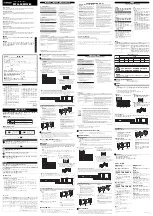
Digital Output Modules
•
13
Contact Protective Circuit for Relay Modules
WAGO-I/O-SYSTEM 750
I/O Modules
2.1.2 Contact Protective Circuit for Relay Modules
Switching off inductive loads such as contactors and solenoid valves can gen-
erate transients with voltage peaks of up to several thousand volts. Very often,
these transients exceed the permissible limits specified in the EMC standards.
They must therefore be limited by using external circuits. Furthermore, they
cause an arc, which may destroy the switching contact, and have a significant
impact on the lifetime and safety of the relay.
The following protective circuits, which are directly connected to the source
of the interference in parallel with the consumer, have proved successful in
practice:
Load Protection
Addi-
tional Off
Delay
Defined
Induction Voltage
Limitation
Bipolar
Effective
Attenuation
Advantages/Disadvantages
Diode
U
D
Load
g051211e
long yes
(U
D
) no
Advantages:
- easy implementation
- cost-effective, reliable
- uncritical dimensioning
- low induction voltage
Disadvantages:
- attenuation only via load
resistor
- long off delay
Series connection di-
ode/zener diode
U
ZD
Load
g051212e
medium to
short
yes (U
ZD
) no
Advantages:
- uncritical dimensioning
Disadvantages:
- attenuation only above
U
ZD
Suppressor diode
U
ZD
Load
g051213e
medium to
short
yes (U
ZD
) yes
Advantages:
- cost-effective
- uncritical dimensioning
- limitation of positive peaks
- suitable for A.C. voltage
Disadvantages:
- attenuation only above
U
ZD
Varistor
U
VDR
VDR
Load
g051214e
medium to
short
yes (U
VDR
) yes
Advantages:
- high power absorption
- uncritical dimensioning
- suitable for A.C. voltage
Disadvantages:
- attenuation only above
U
VDR
R/C combination
U
R
C
RC
Load
g051215e
medium to
short
no yes
Advantages:
- HF attenuation via power
storage
- suitable for A.C. voltage
- level-independent attenua-
tion
Disadvantages:
- exact dimensioning required
- high inrush current































